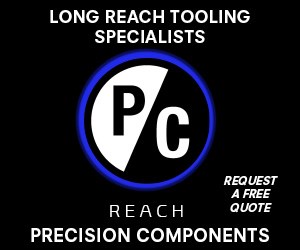The 'Issues' With Height Gages
Don't tell anyone, but there is something of a problem with height gages. The big issue that they have is what they measure: height.
Don't tell anyone, but there is something of a problem with height gages. The big issue that they have is what they measure: height. The larger the height gage, the bigger the potential problem.
It's not actually the height that is the problem. It's the relationship of a large height to the small base. Just like for a lever—the longer the arm, the larger the multiplying factor—for a height gage this is a problem. I am not only talking about the errors coming from the gage itself, but also the errors in the setup. These get magnified and can potentially distort an otherwise carefully planned comparison.
A major error in the design of a basic height gage is taking a design that was meant to measure 12 inches and simply extending the post to measure 36 inches without changing the base design or the cross area of the measuring post. What then happens is that the gage will tend to wobble and flex. Although you may not be able to see the 0.001-inch wobble, it can become a significant part of the part tolerance and can certainly influence measurement.
A normal step in trying to increase the performance of the gage is to beef up the column in an attempt to reduce the flexure of the post. However, this only gets us part of the way to a better gage. For example, if slight pressure is placed horizontally against the gage's measuring contact, the gage may slide along the table. If the same force is applied to the measuring contact when it is near its maximum upper position, this force will likely cause the gage to tip over. What you need to do is to make the base longer and wider and build in some mass. By decreasing the ratio of the post to the base, there will be significant improvement in its performance.
In addition to its own personal issues, the height gage tends to keep company with tools that have bad references. Most height gages are used with a surface plate. The surface plate provides the reference for the part and the height gage. Many surface plates are clean and well maintained. But there are those that may not be as clean as they look. A small metal chip or even a hair, while almost impossible to see, could throw off the measurement by 0.020 inch at a height of only 10 inches.
Next to dirt, the actual surface of the granite surface plate plays a key role in the performance of the gage. Any slight imperfection between where the part and the gage are staged will be amplified the higher the measurement. Most surface plates have a flatness spec of 50 microinches. If the base is 6 inches long, a 50-microinch error would grow to more than 0.0003 inch in 36 inches.
As a concerned parent to your height gage, it's up to you to deal with its issues and choose who will be working with it. Look at the height gage to make sure it is beefed up for the job, and check to make sure it has a precision surface to rest on.
Related Content
6 Machine Shop Essentials to Stay Competitive
If you want to streamline production and be competitive in the industry, you will need far more than a standard three-axis CNC mill or two-axis CNC lathe and a few measuring tools.
Read MoreParts and Programs: Setup for Success
Tips for program and work setups that can simplify adjustments and troubleshooting.
Read MoreChoosing the Correct Gage Type for Groove Inspection
Grooves play a critical functional role for seal rings and retainer rings, so good gaging practices are a must.
Read MoreDetermining Out-of-Roundness at the Point of Manufacture
George Schuetz, Mahr Inc.’s Director of Precision Gages, offers these techniques for measuring roundness on the shop floor.
Read MoreRead Next
Obscure CNC Features That Can Help (or Hurt) You
You cannot begin to take advantage of an available feature if you do not know it exists. Conversely, you will not know how to avoid CNC features that may be detrimental to your process.
Read MoreSeeing Is Believing: 3D Vision System Enables Bin-Picking Robot
With the help of a 3D vision system and robotic arms from FANUC, MetalQuest was able to automate a physically challenging bin-picking task.
Read More3 Mistakes That Cause CNC Programs to Fail
Despite enhancements to manufacturing technology, there are still issues today that can cause programs to fail. These failures can cause lost time, scrapped parts, damaged machines and even injured operators.
Read More













.png;maxWidth=300;quality=90)

 – Medium Rectangle (1).png;maxWidth=300;quality=90)







